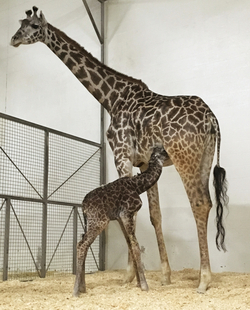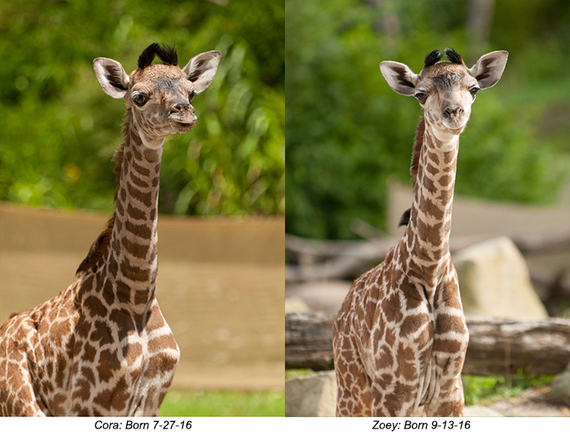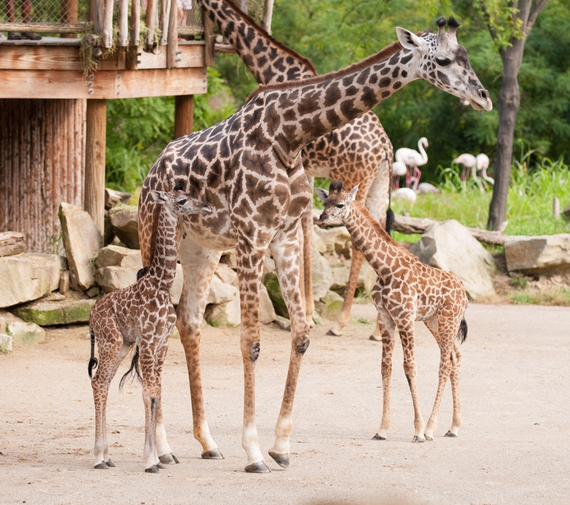Two-month-old Cora and two-week-old Zoey, Cincinnati Zoo & Botanical Garden's female Maasai giraffe babies, can be identified by more than their spots. Similar to a human's fingerprints, giraffe spot patterns are unique to each individual and can be used to tell them apart. If you're not close enough to examine the spots, it shouldn't be too hard to identify Zoey and Cora by their behavior.
"Cora has been spunky and independent since day one," said Zookeeper Jenna Wingate, who has witnessed the births of all five giraffes born at the Cincinnati Zoo in the last decade. "Her mom, Cece, did not provide easy opportunities for her to nurse, so she had to be pushy and persistent in order to get nourishment."
 Zoey's start was much different. "She stood and nursed within the first hour after birth," said Christina Gorsuch, curator of mammals at the Cincinnati Zoo. "Jambo stood rock solid for nursing all night, which is exactly the behavior you hope to see. They did so well together that we felt confident putting everyone outside together only a few days after Zoey was born. Dad, Kimba, was nearby throughout the entire birth and joined the herd with no issues."
Zoey's start was much different. "She stood and nursed within the first hour after birth," said Christina Gorsuch, curator of mammals at the Cincinnati Zoo. "Jambo stood rock solid for nursing all night, which is exactly the behavior you hope to see. They did so well together that we felt confident putting everyone outside together only a few days after Zoey was born. Dad, Kimba, was nearby throughout the entire birth and joined the herd with no issues."
Kimba's keepers describe him as being a good dad and a dependable animal. He shifts easily from one section of the barn to another, which is important when other giraffes need to be isolated for medical exams or to give birth. He is also "great with the females."
Look closely at the photo above and you'll see a heart-shaped spot on Cora's shoulder. That spot was the inspiration for her name, because Corazon means heart in Spanish. The pattern on the right side of her neck looks like a vertical row of bricks. Zoey's chest pattern resembles her mom's, which keepers compare to "six pack abs."
If you see the babies out in Giraffe Ridge, Zoey is likely to be right beside her mom. She nurses frequently throughout the day and watches her mom, and Cora, for behavioral cues. Cora is already eating alfalfa and browse and tends to explore the yard by herself. She does most of her nursing at night.
The Cincinnati Zoo's history with giraffe births dates back to 1889 when it became the first zoo in the Western Hemisphere to produce a baby giraffe. Zoey is the 15th giraffe born in Cincinnati.
Both five-year-old moms, Jambo and Cece, came to the Cincinnati Zoo in 2013 on a breeding recommendation from the Association of Zoos and Aquariums' (AZA) Species Survival Plan (SSP). The sire came to Cincinnati in 2008 from the Roger Williams Park Zoo in Providence, Rhode Island. The other adult female in the herd, Tessa, has produced three calves with Kimba.
Giraffe Facts in North American AZA population:
• The current SSP population of Maasai giraffes includes 120 animals (57 males, 63 females) held by 28 AZA institutions and 4 non-AZA institutions.
• 17 births this year in the population -including Cora and Zoey
• Target Population is 150 animals.
• Demographic analyses suggest that 17 births are needed over the next two years (8 - 9 per year) to maintain the current population size, while 35 births are needed over the next two years (17 -18 per year) to maintain a growth rate of 7% and grow toward the RCP target size.
• Kimba and Cece are a very genetically valuable breeding pair.
• Females are always helpful in the population since most zoos manage a single bull with multiple females.
• Historically, this is the most populous of the subspecies, now numbering an estimated 32,500 in the wild. However, this number is estimated to be a reduction of 30-50% over the last 20 years.


